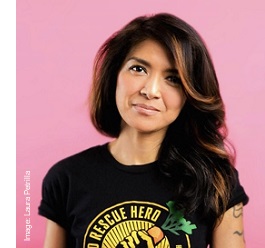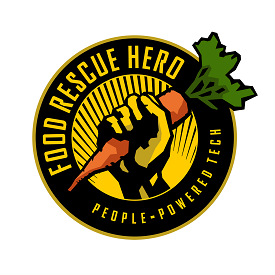

The U.S. Department of Agriculture (USDA) defines food insecurity as being "uncertain of having, or unable to acquire, enough food to meet the needs of all their [household] members because they had insufficient money or other resources for food." The most recent USDA report found that there were over 38 million people in the U.S. living with food insecurity in 2020.
Leah Lizarondo is working to address this huge problem with her app, Food Rescue Hero. By connecting food retailers with volunteer drivers to deliver surplus food to nonprofits, Food Rescue Hero is able to make sure that excess food is able to be distributed to those in need.
 Please tell
us a little about yourself.
Please tell
us a little about yourself.
I was born in Manila, Philippines and lived there until my mid-20s.
I loved growing up with my extended family. I had 12 cousins who
were like my siblings! I worked for Colgate-Palmolive in Brand
Management right out of college and moved to New York City then
transitioned to my first job in technology working as a Product
Manager for a platform that served the consumer goods market.
I first moved to Pittsburgh to go to Heinz College at Carnegie
Mellon University for my Master’s Degree in Public Policy. I majored
in technology policy and urban studies. Then I went back to New York
City to work for a consulting firm and boomeranged back to
Pittsburgh to raise my family. I’ve been here for 15 years! Time
flies.
I love food and cooking. I also love to draw and dance. These
balance out the fact that my work is mostly mental work. I think
balancing thinking with physical work is so essential.
How did the idea for Food Rescue Hero come about?
I have always wanted to find a way to combine my passions for food,
technology and social impact.
After reading a National
Resources Defense Council report in 2012 titled “Wasted," the wheels started turning. Mostly to
question how such an inefficiency could be happening. My former
partner’s family owned a farm in the city and I worked there for a
couple of summers and that was when I truly understood the value of
food - how much time and resources go into growing what we eat. And
then here we are wasting almost half of it. And when we do that,
it’s not only the resources used in growing food that gets wasted -
the transport, storage and everything else. So much. Food waste is
one of the leading causes of greenhouse gas emissions according to Project
Drawdown, second only to refrigeration. And when you add the
alarming fact that over 10 percent of households are food-insecure,
the imperative to do something about it is unquestionable.
 In 2015, 412 Food Rescue was launched in Pittsburgh as the initial
response to this. We formed this network of food surplus donors,
nonprofit distribution partners and the first volunteer drivers.
Food Rescue Hero was always in my mind as THE way to scale it.
In 2015, 412 Food Rescue was launched in Pittsburgh as the initial
response to this. We formed this network of food surplus donors,
nonprofit distribution partners and the first volunteer drivers.
Food Rescue Hero was always in my mind as THE way to scale it.
So in 2016, we launched this platform that works similarly to all
the food delivery services we are so familiar with today. About 28%
of food waste occurs at the retail level, where businesses encounter
many logistical challenges to donating surplus food. My vision was
to create a technology platform that could mobilize a distributed,
flexible network of volunteer drivers, who could transport fresh,
surplus food to organizations serving food-insecure populations
immediately.
Are there any surprising trends that you have noticed since
launching in 2016?
Food delivery, while growing at a good pace in 2016, truly took off
in the pandemic - out of sheer necessity. ⅓ of households had food
delivered in the past 18 months and ⅓ more will. This convenience,
we have discovered, is now a necessity. In our fast-paced,
time-challenged lives, it is a service that gives us some time for
things we cannot outsource.
But this convenience is still limited to households with privilege.
And ALL households, and I would say more so those who are
experiencing poverty and food insecurity, need access to the same.
Households led by single parents, who hold multiple jobs, who have
no reliable access to public transportation; the elderly, disabled,
and immunocompromised. This is such an easy convenience to GIVE so
that we equalize at least one more thing. And in doing that, give
the same incremental access to time. Such an important currency for
quality of life.
The pandemic has affected people in so many ways, from an
increased number of people suffering from food insecurity to
supply-chain issues. In what ways has it impacted food rescue?
Expanding on the above, the pandemic really exposed the need to
rethink our systems of food assistance. We all saw photos of those
long lines of cars waiting at food distributions, but that was only
the tip of the iceberg. Many people couldn’t even make it to the
line, because they lacked transportation, were working frontline
jobs during the hours that food pantries and distributions were
open, were at home with children doing virtual school, or couldn’t
leave the house because they were immunocompromised.
While those of us with more resources have simply been ordering
grocery delivery and getting on with our days, people in poverty
have had to work very hard and make difficult decisions just to get
the basics.
The federal government jumped in with crucial aid expansions that
prevented hunger from skyrocketing, as we feared it might, but
important inequalities still exist (for instance, the gap between
Black and white households experiencing food insecurity got wider.
More women had to choose between employment and childcare). We need
to think much more innovatively to account for the way people facing
food insecurity actually live and the complex barriers they face.
So we took this opportunity to truly push the envelope and introduce
Home Delivery - for the first time, our food rescue hero drivers
delivered directly to homes in need. This puts our network
capabilities on par to those of commercial services and is truly
disruptive to how we have been providing services to those in need.
I am very proud of my team and all our food rescue heroes for
believing in this. I have absolutely no doubt that we are going to
look back in history and say this was a moment in time where we
ignited massive, impactful change.
Food Rescue Hero has redistributed millions of pounds of
food to those in need. If it isn’t available yet in a city, what
are some other ways one can help?
Food Rescue Hero is currently in 12 cities (and by the end of 2021,
will be in 20 - working toward our goal of 100 cities by 2030.) If
Food Rescue Hero is not yet in your city, we can help you bring it
there. Over the past year, we’ve created an introductory version of
the platform and an educational resource called Food Rescue
University in order to make it easier for start-up organizations to
rapidly launch and scale food rescue in their cities. That could be
you!
What does a typical day look like
for you?
I typically wake up around 5:30 a.m. I have my mushroom drink (isn’t
everyone trying these nowadays?) plus coffee combo, read the news
(this is the only time I allow myself to read the news, because it
just gets so distracting) and messages I may have received on social
media overnight. Then I reach for my journal and books/apps I use
for reflection prompts and write. I meditate - not very long, 10
minutes on weekdays and probably 20 on weekends. Then it’s time to
get my three kids ready for school.
This start of the day routine is sacred time for me. I feel a little
out of sorts all day without it. It centers me and helps me keep
focused on big goals not little things. I’m not an “expert
meditator” by any stretch and I would say that the most discernible
effect this has had on me is that I am more able to not be reactive
to situations. I love it. It offers a sense of peace and a degree of
less flappability that I am reaping the benefits of in major ways.
The rest of my day is unfortunately a lot of meetings. I’m trying to
get this under control because I need to carve out time to actually
DO work.
I pick my youngest up from school around 4 p.m. and then get on with
the evening routine of homework, dinner and bedtime.
I do a short yoga practice every night to wind down.
What is one piece of advice that
you have found to be most helpful?
Do your best. But be very discriminating in the things you choose to
do.
_____________________________
Image: Laura Petrilla
Success of Covid Antiviral Pills Hinges on
Access to Speedy and Accurate Tests
by JoNel Aleccia
Asian Women Who Made History in 2021
JADE Pieces: Tasty (and Sugar-free) Snack Options
Bottoms Up: Terrific Tumblers and Glasses
Who, What, Where and How: AAPI Organizations
Learn More: What Others Are Saying
How to Report Hate Crimes Against AAPIs